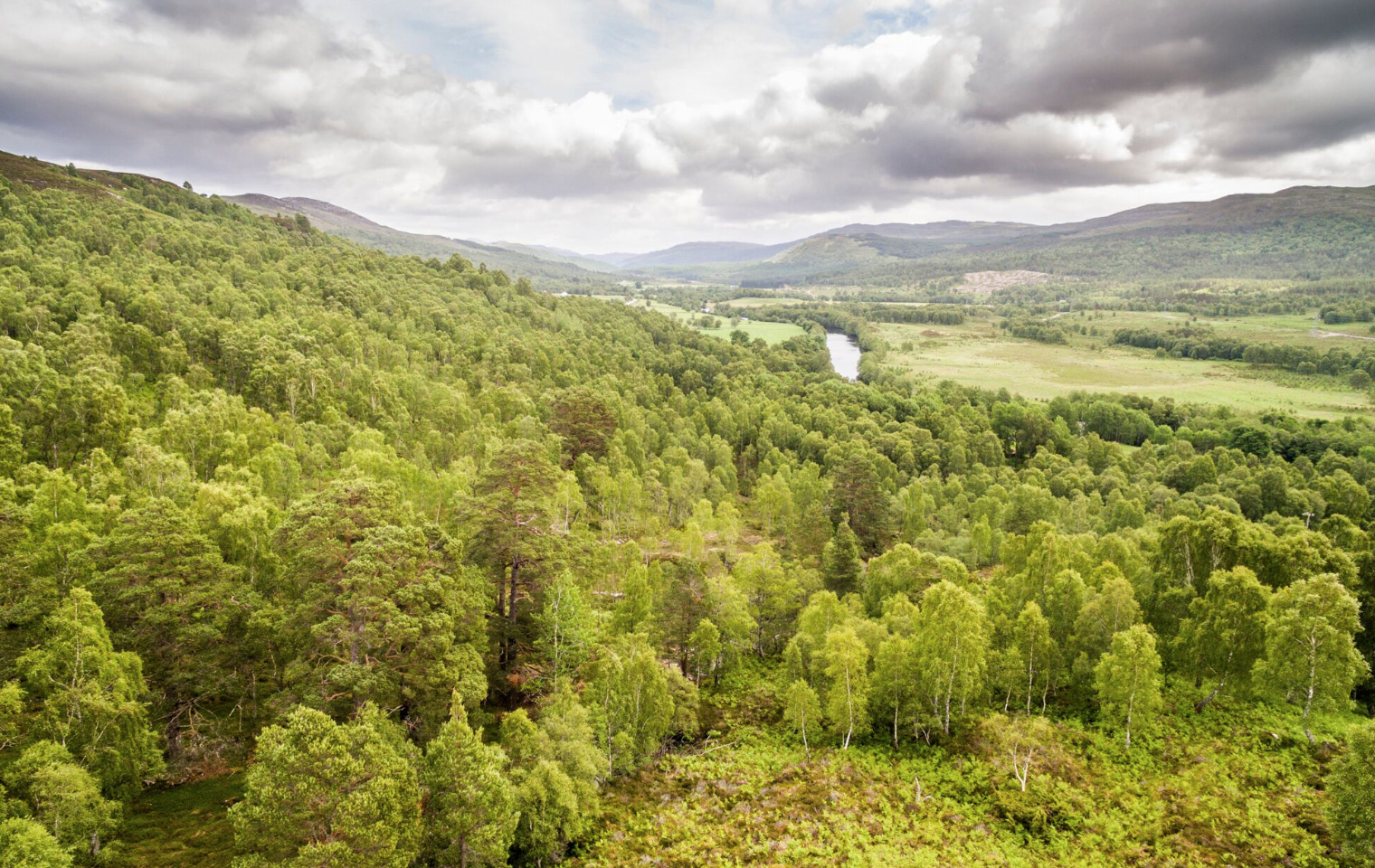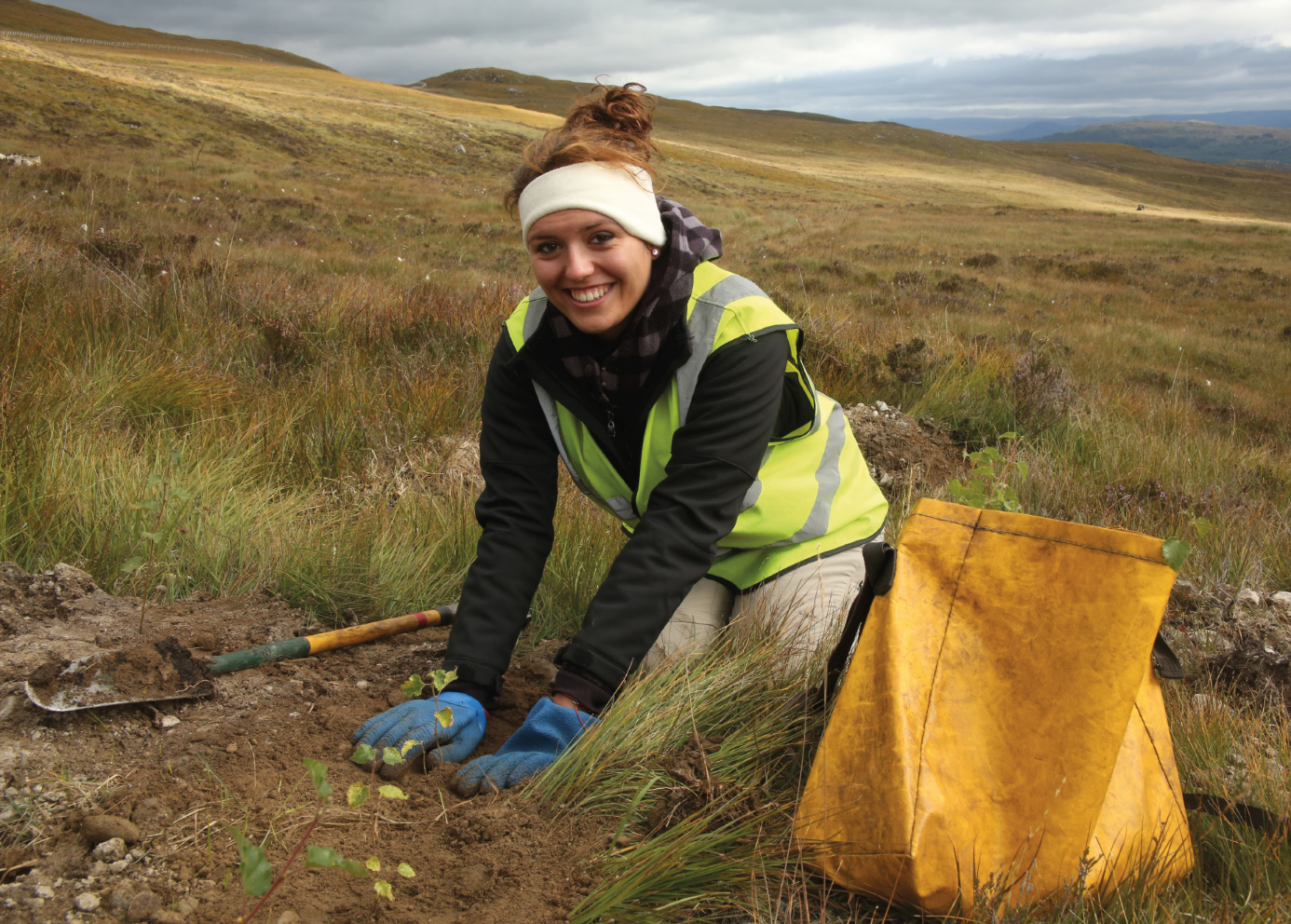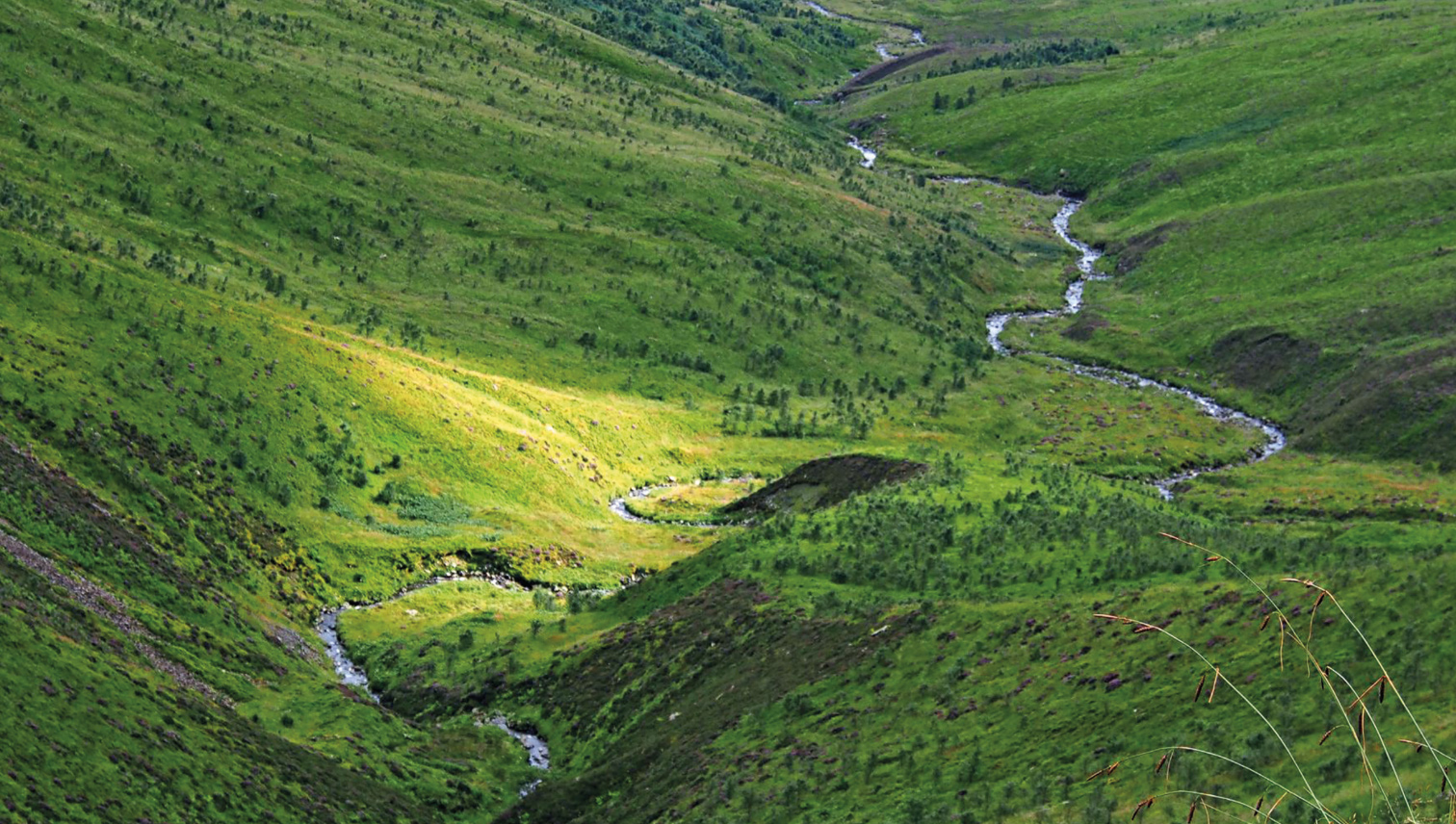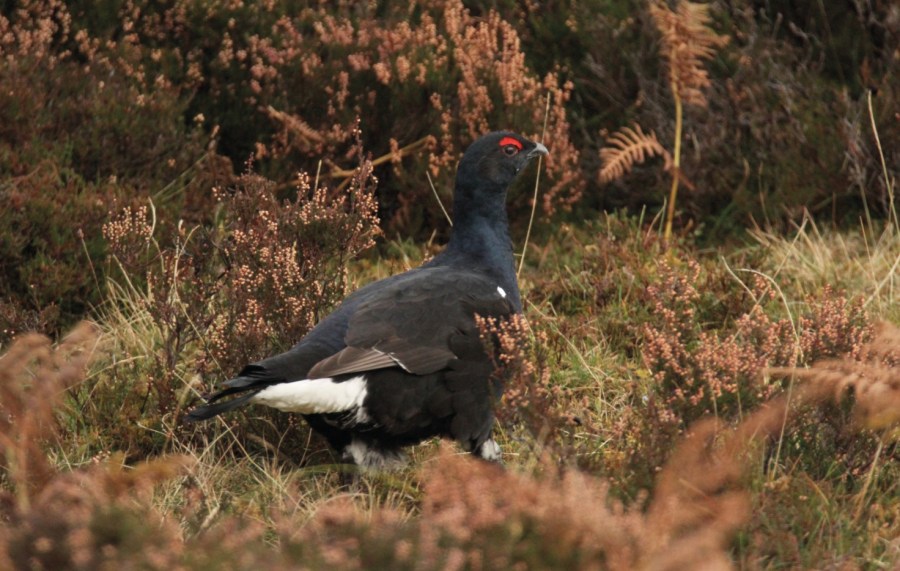Rewilding schemes are gathering steam across the country – so what will the impact be on Britain’s mountains? Hanna Lindon looks to the future.
Forty million birds gone from our skies since the 1960s. That’s one of the scariest stats from Isabella Tree’s 2018 book Wilding, but there are plenty of others that stick in the gullet. Ninety per cent of wildflower meadows lost since the Second World War. Seventy-five thousand miles of hedgerows and countless acres of ancient woodland felled over the same timescale. Common British species – including hedgehogs, dormice and water voles – in the process of total population collapse. According to the 2016 State of Nature report, we are among the most nature-depleted countries in the world.
So what’s the answer? Tree thinks that we need to stop micromanaging the British countryside and create areas where nature can take the driving seat. She and her husband Charlie Burrell have spent the last decade ‘rewilding’ the 3,500-acre Knepp Estate in West Sussex, letting once intensively managed farmland revert to savannah-style wood pasture with the help of free-roaming herbivores. The result has been an explosion in wildlife numbers and an influx of endangered species.
This hands-off approach to conservation is increasingly catching on across our uplands, too. Rewilding Britain recently secured funding to create a “continuous, nature-rich area” across 10,000 hectares of Mid Wales, including the Plynlimon massif. There are already thriving ‘rewilding’ programmes leading the way in areas such as Creag Meagaidh, Ennerdale and Glen Affric. Vast swathes of our hill country are slowly being restored to a more natural state – but what does ‘natural’ really mean, and how will the restoration affect those of us who love the mountains?
Transforming landscapes
Picture the view from your favourite summit. The chances are you’re imagining cropped grassy slopes shot through with scree chutes and gullies, perhaps with the odd blasted tree hanging on here and there. That view might feel wild, but it actually owes as much to the hand of man as the drained fens of East Anglia or the orchards of Kent. Close grazing, mainly by sheep or deer, has robbed our uplands of almost all their plant and tree life.

Dundreggan. Copyright © James Shooter
“The tree line in this country is actually much higher than people think it is,” explains Alan McDonnell, Conservation Manager at Scottish rewilding programme Trees for Life. “Even around 700-800 metres, vegetation can be more than just heather or mosses – you can have shrub species growing there.”
At Dundreggan, Trees for Life’s flagship site, the land is slowly recovering from centuries of overgrazing. A decade after forest regeneration began, conservationists are beginning to see the first glimmers of a more natural upland ecosystem.
“Ten years ago, we inherited pretty much a bare-hill site,” says McDonnell. “Think rocks coming through, scraps of heathers here and there, trees hanging on in rocky, craggy areas or deep gullies. Now we’re seeing younger trees coming up, thicker vegetation on the ground, more flowering species and lots of interesting insects. There are signs that the woodland condition has thickened up and feels heartier. You can see the shape of a natural woodland emerging.”
Trees for Life isn’t the only rewilding project restoring tree cover to the Scottish Highlands. The valley of Carrifran in the Moffat Hills has been transformed from ecological desert to emerging woodland ecosystem since it was purchased by public subscription on Millennium Day. Creag Meagaidh’s deer culling project has led to tree cover creeping uphill towards the Coire Ardair rockface. Replanting and deer fencing by the John Muir Trust is bringing woodland cover back to Knoydart.
Perhaps most promisingly, Scotland’s largest private landowners have begun plans to kick-start a vast rewilding project across their 80,000-hectare estates.
Wildland, the company owned by Danish billionaires Anders and Anne Holch Povlsen, has already planted over 1.5 million native trees and embarked on a scheme to control the local deer population. Plans are now afoot to reintroduce long-lost montane scrub habitats around the hills of Glenfeshie.

A Trees for Life Volunteer. Copyright © Trees for Life
The cultural case against rewilding
At Dundreggan, Glenfeshie and a score of other sites, the signs are that upland areas given space to breathe will slowly develop more tree and shrub cover. Rewilding of this kind seems somehow a more natural prospect in Scotland, where the old Caledonian Forest still has a place in cultural memory – but the prospect of wooded mountains is far more controversial in landscapes that have been sheep-grazed for many hundreds of years.
The bare hills of the Lake District, straddled by drystone walls and dotted with Herdwick sheep, are considered so iconic that they were recently protected by World Heritage designation. To some, the idea of rewilding the fells is tantamount to heresy. In Ennerdale, though, a wildland partnership is proving that wilderness can have a place in areas where hill farming has long reigned supreme.
“Wild Ennerdale has been going for about 17 years,” says Gareth Browning of the Forestry Commission. “There was originally a conifer forest here that was planted between the 1920s and 1950s – it was fairly monoculture and mono-age. Many people complained they couldn’t really see the mountains and the river.
“In the valley bottom we’ve felled conifers, allowed regeneration, planted broadleafs and moved from intensive sheep grazing to extensive cattle grazing. People walking up the valley now say they really enjoy it because they get views of the lake, river and mountains, and the forest around them is more diverse.”
The opposition to ‘mountain forests’ in the Lakes, he argues, arises out of a misunderstanding.
“We don’t have many examples of natural mountain woodlands to compare to in the UK, so we look at what’s in the valley bottoms and project that onto the mountains,” he explains. “That isn’t what our uplands will look like with trees on them.
“There’s a grazing exclosure on Ben Lawers where some seed planting has been done and things have grown up over time. It’s quite open with patchy tree cover, and butterflies and birds at a much higher level than you’ll see outside of the exclosure.”
But reforested uplands – even relatively open ones – are anathema to many Lake District farmers and to some visitors as well. When the National Trust bought a 300-acre Borrowdale hill farm back in 2016, it sparked a vitriolic argument between adherents of traditional sheep farming and environmentalists in favour of rewilding the site. This ‘people versus nature’ conundrum is one that still rages over many developing upland rewilding schemes.
People versus nature
MP and erstwhile prime ministerial candidate Rory Stewart famously argued that rewilding leaves no place for people in the landscape.
“The ultimate object of rewilding,” he wrote, “is to remove all human impact from the landscape. Unlike a conventional environmental scheme, which relies on carefully scientifically-tested human interventions (tree planting, river management, seasonal grazing and the rest), this aims to allow animals and plants to restore the landscape by themselves, through entirely natural processes, by reinserting extinct animals which humans removed from the landscape, centuries or even millennia ago: predators such as lynx and wolves, or high impact species such as beavers and bison, which can control the landscape ‘top-down.’”

Carrifran
It’s criticism in this vein that has dogged the Summit to Sea project, which aims to restore ecological diversity in a vast area between the Cambrian Mountains and Cardigan Bay. “Cultural imperialism” was how one councilor described it. The Farmers’ Union of Wales called for the scheme to be scrapped, arguing that it would drive farmers out of local communities. So what might the impact be on walkers?
“In visual terms, we wouldn’t expect the area to be immediately transformed,” says Rory Francis of the Woodland Trust, a co-partner in Summit to Sea. “After ten years or so we would hope that there would be rather more woodland, rather more rough edges between woodland and open land, fewer hard lines on the map between solid blocks of conifers and the pastures around them. Most importantly, we’d hope to see a greater richness in wildlife.
“We’d also like to see a lot of peat bogs restored so that they become once again gloriously wet. That might make them more difficult to walk through, but it’ll be worth the effort all the same!”
Francis argues that the project also has the potential to benefit farmers. “We want to support sustainable farming practices,” he says. “We’re not about reintroducing predators.”
The wolf in the room
This is where conservationists begin to argue among themselves. Because many believe that the rewilding model espoused by Knepp and Wild Ennerdale, which itself borrows from the theories of Dutch ecologist Frans Vera, isn’t really rewilding at all.
Projects like these have introduced ‘free-roaming’ herbivores in a bid to mimic conditions that would have existed before humans drove species such as aurochs and moose to extinction in Britain. There are two issues that opponents raise with this approach. Firstly, animals are kept within fenced enclosures and prevented from migrating to find new food sources. To control herbivore numbers and prevent over-grazing or animal starvation, humans then have to take on the role of predator.
“How can a human contrive a situation of predation?” asks Mark Fisher, founder of Self Willed Land and a member of the Wildland Research Institute. “Predators influence the movement of grazing animals. You wouldn’t get a deer, an aurochs or any other native herbivore grazing around a wolf’s den. So you’d see trees starting to grow there.”
Fisher argues that introducing herbivores to landscapes already blighted by over-grazing is inconsistent with natural regeneration. He supports projects such as Carrifran, which is focusing on the growth of native vegetation without importing grazing animals. Mainly, though, he’s been fighting for the creation of “real, natural systems” free from farming and human influence, and the reinstatement of predators such as lynx and Scottish wildcat.
Is this something we could eventually see in the British uplands? Several species have been brought back from the brink or reintroduced to Britain in recent years, including beaver, golden eagle and (less deliberately) wild boar. Reclusive lynx are probably the most likely candidate for a predator reintroduction – but there’s strong opposition from farmers and it’s hard to see how any project could work without their support.
“A lot of the NGOs, like ourselves, are clear that reintroduction of lynx would only work by consensus,” says Trees for Life’s Alan McDonnell. “It would have to start by talking to everybody with an interest in the landscape. Any reintroduction that tries to bypass that is doomed.”
Wild and wonderful
With that crucial missing link in the food chain, the ‘rewilded’ landscapes we’re seeing spreading across Britain’s uplands can’t ever be wild in the purist sense of the word. On the other hand, they can and they do encourage increased biodiversity and booming wildlife populations. Ennerdale has seen a 25% increase in bird species since the inception of the Wild Ennerdale project. Walkers crossing ‘rewilded’ Knoydart can spot pine martin, bats, roe deer and a whole host of birds. Juniper, high-altitude willow, birch, aspen and elm all thrive on the slopes of Dundreggan. Birdsong echoes around the Carrifran valley.
The one thing that all rewilders seem to agree on is that connectivity is essential for wildlife to flourish. The future of conservation, they contend, doesn’t lie in SSSIs or nature reserves – tiny pockets of biodiversity hemmed about by lifeless agricultural seas. We need corridor-linked networks of rewilded land across the country.
That’s why we can expect to see the continued expansion of rewilding schemes across our mountain and upland landscapes – and, for many of us, it’s an enticing prospect.
Featured Image: Katy Rewston







